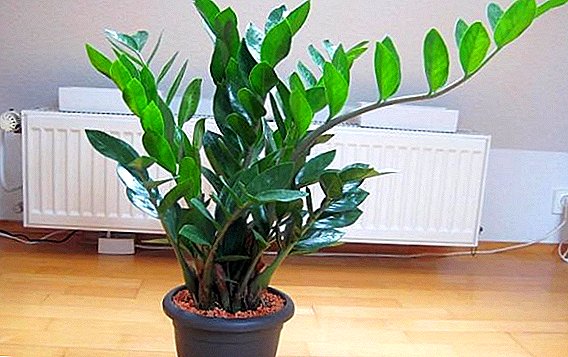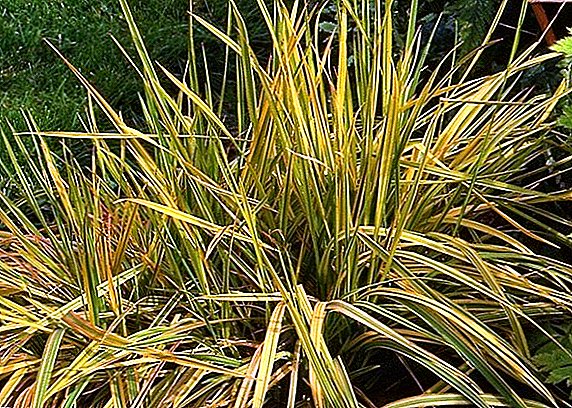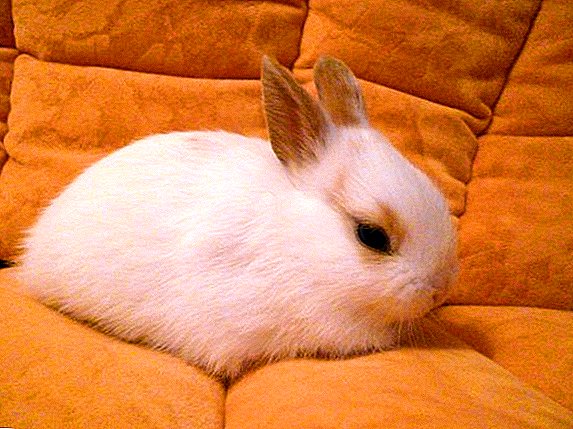 Decorative rabbits are the best gift for children. They are cute and pleasant animals, the maintenance and care of which brings a lot of joy to the owners. The cost of keeping krols low, in addition, they are well amenable to education. They do not need to walk, as they can be accustomed to the cat tray.
Decorative rabbits are the best gift for children. They are cute and pleasant animals, the maintenance and care of which brings a lot of joy to the owners. The cost of keeping krols low, in addition, they are well amenable to education. They do not need to walk, as they can be accustomed to the cat tray.
In this article we will tell you about which rabbits are better to buy and how to care for them at home.
Did you know? The life span of a rabbit in the wild is about a year, while a domestic rabbit can live 8-12 years with proper care.
Choice of breed of decorative rabbits
Before you buy, you need to understand what kind of decorative rabbit you want to see at home.
Hermelin
 Rabbits of this breed have blue or red eyes, and their wool is always white. He has a massive head and thick short hair. These rabbits weigh up to 1.5 kg. The nature of the females and males is markedly different. Males are calm, they are friendly towards people. Also they may be lazy or not like too much anxiety. Females are pretty nervous or even aggressive. We recommend buying a male.
Rabbits of this breed have blue or red eyes, and their wool is always white. He has a massive head and thick short hair. These rabbits weigh up to 1.5 kg. The nature of the females and males is markedly different. Males are calm, they are friendly towards people. Also they may be lazy or not like too much anxiety. Females are pretty nervous or even aggressive. We recommend buying a male.
Colored dwarfs
This breed of dwarf rabbits is characterized by erect ears. The weight of the rabbit reaches 1.5 kg. There are many varieties of color: white-and-white, black-fire, laughter, Siamese, white, red and marder. Especially often buy red satin. They have a red color. By character, they also differ: they can be affectionate, friendly, and sometimes aggressive. During puberty, they are very aggressive: they can bite or throw at people. But over time it will pass.
You can win the love of rabbits of this breed by scratching your cheeks and forehead between the ears. Unlike long-haired rabbits, colored dwarfs do not need to be combed out.
Fold (sheep)
 These rabbits are a bit more dwarfed. The weight of an adult crawl is up to 2 kg. Their ears hang down, and this creates the impression of a peaceful and calm nature. These rabbits love to eat well. Ears fall from them gradually, but rabbits grow very quickly. By the time the rabbits knock 4 weeks, their ears will drop. If your rabbit at this age has one ear will stand, you should not worry, as over time the ears fall completely. Their character is calm and friendly, they do not show aggression towards people. Quickly attached to family members.
These rabbits are a bit more dwarfed. The weight of an adult crawl is up to 2 kg. Their ears hang down, and this creates the impression of a peaceful and calm nature. These rabbits love to eat well. Ears fall from them gradually, but rabbits grow very quickly. By the time the rabbits knock 4 weeks, their ears will drop. If your rabbit at this age has one ear will stand, you should not worry, as over time the ears fall completely. Their character is calm and friendly, they do not show aggression towards people. Quickly attached to family members.
"Fox" dwarf rabbits
These are dwarf rabbits with long, smooth hair. Weigh up to 1.5 kg. They are called fox because their wool is strong and thick. The length of a hair can be up to 7 cm. There are different colors: white, blue, red, chinchilla and others. Their nature is different - they are gentle, and may be aggressive. Rabbits need to be combed out once a week, and if you are not ready for this, then fox rabbits are not your breed.
Angora Dwarf Rabbits
 These rabbits have thick fur all over their body and muzzle. Their wool is more like down. It is very soft and thin, it can reach 20 cm in length. Most often, they can even be confused with small dogs. The weight of rabbits can reach 1.5 kg. The character ranges from calm to aggressive. They also need to be combed often, especially during shedding.
These rabbits have thick fur all over their body and muzzle. Their wool is more like down. It is very soft and thin, it can reach 20 cm in length. Most often, they can even be confused with small dogs. The weight of rabbits can reach 1.5 kg. The character ranges from calm to aggressive. They also need to be combed often, especially during shedding.
Rex
These are short-haired rabbits with velvety short hair of various color. They weigh up to 1.5 kg. Small they seem very ugly, but with age they become real handsome. Their character is calm, they do not show aggression.
Buying Tips
As soon as you choose for yourself a breed of decorative rabbit, you can go shopping.
To purchase the breed you need, you need to know exactly what the decorative rabbit is different from the usual. Since they are sold small, you will not notice any special differences, but when you buy you must show pedigree documents and medical certificates. Therefore, it is better to contact the sellers of proven pet stores with a good reputation. There are several points that you should clarify when buying rabbits:

- Inspection of the cell. If it is dirty and smells unpleasant, it is better not to buy an animal.
- Relatives. You just need to ask the seller to show the parents or siblings of the rabbit. If they are not of the same size, they are a mixture of breeds, and it is better to choose another rabbit.
- The rabbit should not be mats, dirt on the face and ears.
Who to choose: male or female
If you still doubt whether to start a decorative rabbit, then our answer is obvious - it is worth it. These furry animals will bring you a lot of joy and happiness. But the choice of breed and inspection of the animal does not end the choice. There is a new task - the choice of the sex of the rabbit.
Rabbit males emit specific odorous substances with which they mark the territory. Females are also tagged, but males can be neutered and thus solve the problem with an unpleasant odor.
The female may have uterine cancer. This happens if she has no partner. There are two ways to avoid this - sterilization or buying a male.
 Also, females love to build nests from everything that falls into their paws. These can be wires, wallpaper, cardboard, newspapers and other things. This is eliminated by sterilization.
Also, females love to build nests from everything that falls into their paws. These can be wires, wallpaper, cardboard, newspapers and other things. This is eliminated by sterilization.
If you have listened to the advice of the seller about the fact that male rabbits behave more playfully than females - this is not true. It depends on the upbringing, the treatment of the animal and the character of the rabbit.
How to care for little rabbits: content at home
After buying a decorative rabbit, you need to know how to follow him at home.
Did you know? The smallest breed of rabbits is called Little Idaho, or pygmy rabbit. The weight of an adult individual reaches a maximum of only 450 g, and its length ranges from 22 to 35 cm.
Animal cage
Before you buy a rabbit, you need to provide the animal a house.
You can buy an enclosure area of 2-4 square. m The floor space can be covered with a clean hypoallergenic mat.
 In the corner you can place the drinker in the form of a ceramic bowl. Automatic ball drinkers will not work, as the ball enters the water supply tube, and the rabbit stays without water for a long time. Water needs to be changed in the morning and in the evening.
In the corner you can place the drinker in the form of a ceramic bowl. Automatic ball drinkers will not work, as the ball enters the water supply tube, and the rabbit stays without water for a long time. Water needs to be changed in the morning and in the evening.
The food bowl must also be ceramic, as the rabbit cannot turn it over. Plastic and metal in this regard are light and dangerous. The rabbit gnaws them and bends it, afterwards it can cut itself on the edges.
The tray fits feline, it can be put in a corner and covered with wood granulated filler. Feline fillers are not suitable, as they can cause a side effect in the form of allergies. Wood filler well absorbs odors from the decorative rabbit, and it is more convenient to dispose of it.
Since rabbits love hay, you can attach a plastic hay holder to the enclosure wall. The rabbit takes out hay at any time, and it will not be scattered throughout the enclosure.
It is not necessary to buy an additional house for a rabbit, but in it the animal can retire and rest. You can do it yourself or buy it at the pet store. Usually rabbits love to sleep there.
 As you can understand, domestic rabbits do not cause great difficulties in maintenance and care, and with the aviary the task becomes even easier.
As you can understand, domestic rabbits do not cause great difficulties in maintenance and care, and with the aviary the task becomes even easier.
When choosing cells or accessories, we offer a few tips.
If your rabbit likes to run around the house, then you can not buy a large aviary. You can simply buy a medium sized cage and leave the door open.
Important! When the rabbit leaves the enclosure, be alert, as the animal can damage the apartment.A small rabbit cage is not suitable, as adult rabbits love to run. The pallet, which is in the cage, should not be retractable, as the part in the cage still remains. You also need to maintain purity in the cells or aviary. It needs to be cleaned every day and a general cleaning once a week. You need to get the rabbit from the cage to the aviary, give him some food, water and a couple of toys.
 From the cage you need to get the old food, dirty litter, fur and hay, but do not completely remove everything. It is better to leave some kind of cloth or a bowl for food or water, as the rabbit may not feel its smell and get worried. Next time, remove this corner and leave the other untouched.
From the cage you need to get the old food, dirty litter, fur and hay, but do not completely remove everything. It is better to leave some kind of cloth or a bowl for food or water, as the rabbit may not feel its smell and get worried. Next time, remove this corner and leave the other untouched.
Then you need to check the condition of the cage and the rabbit itself. By the amount of food or drink, you can determine how much your rabbit drinks and if it has a good appetite. We also recommend that you pay attention to the rabbit waste. The cage must be checked for damage or various holes. Some holes or sharp bent corners can harm the rabbit. Toys that have been damaged or worn should be discarded.
The bottom tray needs to be cleaned, the litter is replaced. After that you can put new toys in the cage and return the rabbit to its place. For weekly cleaning you need to prepare the following:
- hard brush;
- bucket;
- a toothbrush (it will be needed for cleaning corners and hard-to-reach places);
- vinegar spray;
- garbage bag;
- dishwashing liquid;
- gloves.
 It is best to choose a convenient day (weekend) to do a general cleaning. This will help avoid rapid contamination of rabbit fur and diseases that can trap the animal.
It is best to choose a convenient day (weekend) to do a general cleaning. This will help avoid rapid contamination of rabbit fur and diseases that can trap the animal.Move the rabbit to another place before cleaning. Do not forget about water, food and toys so that the rabbit does not get bored.
Then you gently remove the old bedding, hay, fur, watering and feeding trough. After that, put on gloves and start cleaning.
Important! After using the gloves, put them in a garbage bag to use in the next cleaning.Again, the cage cannot be completely cleaned; it is better to leave a corner marked with a rabbit so that it does not bother when you return it to the cage.
Use a hard brush to clean the cage. You will need warm water and dishwashing detergent. After you clean the cage, use a toothbrush to clean the soiled corners.
Never use chemicals. They can harm the health of the rabbit.
 White vinegar will be the best remedy. Prepare a solution of 1 part vinegar and 1 part warm water. Pour the mixture into a spray bottle and spray it on the cage after cleaning. Vinegar should stay in the cage for 10 minutes. After that you need to wash the cage, avoiding the corner left for the rabbit.
White vinegar will be the best remedy. Prepare a solution of 1 part vinegar and 1 part warm water. Pour the mixture into a spray bottle and spray it on the cage after cleaning. Vinegar should stay in the cage for 10 minutes. After that you need to wash the cage, avoiding the corner left for the rabbit.
Then you need to put the cage on the balcony. Sunlight will quickly dry the cage and you will quickly return the rabbit to its place. Water and food feeders must be disinfected with liquid soap and hot water.
At the end, lay out a new litter and put everything in its place. Now you can return the rabbit to the place, and dispose of all waste.
After cleaning all accessories can be hidden in the usual place for them and wash hands thoroughly.
Important! If your rabbit is sick or was sick, the cage must be cleaned very carefully.
Place for rabbits
The cage must be placed in a well ventilated place. There should be an optimum temperature, without dust and dirt. This place should be bright, but the light should be diffused. The place should not be near the drum dryer or where the window will be constantly open. Sharp and loud movements or sounds expose the rabbit to unnecessary stress.
Rabbit to protect from cats or dogs. They may disturb or frighten him.
 You also need to release the rabbit "at will". In the room in which the walk will take place, there should be no wires, sharp objects, small toys and other objects that could harm the animal.
You also need to release the rabbit "at will". In the room in which the walk will take place, there should be no wires, sharp objects, small toys and other objects that could harm the animal.
Since the size of the decorative rabbit is small, it does not need much space. It will be enough to arrange a walking place on a bed or carpet.
Walking and games for krols
Walking in nature is best done in the warm season, that is, in spring or summer. It is necessary to accustom to such walking rabbits gradually - first bring it out for 10 minutes, and next time for 20, and so on. The best place for a walk is a green lawn, where dogs do not walk.
Before the first walk, the rabbit must be treated with parasites (fleas and ticks) with a special agent.
If you have a dacha, then there you can place an open-air cage where the rabbit will quietly play. If there is no aviary, then you can keep it on a harness. The aviary should be placed in the shade so that the rabbit does not get heatstroke. But it's better not to hold a rabbit on the harness. Some believe that this can harm the health of the rabbit, let alone discomfort.
 A rabbit can be stressed. You will learn about it very quickly by his behavior. He can lie down on the ground and not get up, bulge his eyes, rush from side to side, trying to get out, often run in different directions.
A rabbit can be stressed. You will learn about it very quickly by his behavior. He can lie down on the ground and not get up, bulge his eyes, rush from side to side, trying to get out, often run in different directions.
If you have a cottage, you need to worry about the following:
- The rabbit should not run off the site.
- The site should not be poisonous plants.
- Rabbit need to teach to eat grass and greens.
- The animal needs to prepare food and water, as well as toys.
Important! Before walking, the rabbit must be vaccinated against UGBC and myxomatosis.You need to bring the rabbit at a temperature of up to 23 ° C, but if you decide to walk with the rabbit in winter weather, then you need to train him in the fall to low temperatures in advance.
If you decide to walk two unfamiliar rabbits, it is better not to. Rabbits can panic, they can be stressful, they can even refuse to eat. Since rabbits have different microflora, your pet may get sick from direct contact with another rabbit. But if you decided to walk the rabbits together, then consider a few important points: 
- Both rabbits must be spayed or neutered, otherwise this walk will result in pregnancy or a fight.
- Rabbits must be vaccinated.
- If your rabbit shows signs of stress, take it home.
In order for the animal not to gnaw on wallpaper or paper, make a “maze” of cardboard boxes with different entrances and exits. Some rabbits love to dig trenches. So that it does not damage the cage, buy a linen rag. Others like to play with balloons or toilet paper. From the above, we can conclude that any toys will work for rabbits, the main thing is to understand what he likes.
Proper and balanced feeding: rabbit diet
 After selecting the cage and the rabbit itself, as well as toys, the owners think about what is needed for a decorative rabbit. The answer is obvious - of course proper and balanced nutrition.
After selecting the cage and the rabbit itself, as well as toys, the owners think about what is needed for a decorative rabbit. The answer is obvious - of course proper and balanced nutrition.
Little rabbits need to change the water frequently. Be sure to ask the seller what kind of water they watered the baby (boiled, separated, filtered or from bottles). The same water and should water the little bunny. Hay needs to be changed very often, and the greener it is, the better.
Feed the rabbits give 2 times a day, 2 tbsp. l You can learn about the brand of feed from the seller. It is necessary to feed this forage for two weeks, then transfer the rabbit to another forage, mixing it with the first one in equal proportion.
Important! A sharp transition from one food to another leads to problems with the gastrointestinal tract.
Vegetables, fruits, branches and grass can be given to rabbits only after the 3rd month. They should be clean, fresh and dry. It is necessary to accustom rabbits to fresh feeds gradually. The rabbit will gnaw the mineral stones, as it may lack calcium or minerals.
Rabbits can not be fed as follows:

- milk products;
- sweet, salty, spicy or fatty foods;
- food from your table;
- citrus;
- spoiled food;
- meat products;
- legumes;
- feed for other animals;
- indoor plants, wet grass;
- cabbage, onions, beets and garlic.
Important! Do not give poisonous plants to rabbits.
Краснокочанную капусту лучше не давать питомцу, подойдет брюссельская капуста или цветная, но только плодоножка, листья и кочаны.
Профилактика и лечение болезней кроликов
 During the purchase, many owners ask the sellers how many decorative rabbits live at home. The average life expectancy is 7-8 years. There are also long-lived people who live up to 10 years or more.
During the purchase, many owners ask the sellers how many decorative rabbits live at home. The average life expectancy is 7-8 years. There are also long-lived people who live up to 10 years or more.
It depends on the following factors:
- healthy parents;
- proper feeding, maintenance and care;
- genes and predisposition of parents to any diseases;
- injuries or diseases that shorten the age;
- active lifestyle rabbit.
Intestinal problems are most common in adult rabbits. They appear in the event that the rabbit consumes poor food, large amounts of legumes and is contained in an uncleaned cage.
Signs of diseases: 
- liquid feces with mucus;
- swelling;
- frequent diarrhea;
- the animal is not active, and its appetite is getting worse.
Constipation. You need to give the rabbit 5 grams of Carlsbad salt or 1 tsp. castor oil or an enema with soapy warm water, then release it to run. When constipation has passed, he can be given oatmeal broth and carrots.
Bloating. Give the rabbit 5 ml of 10% ichthyol solution. After this, rub the belly of the rabbit and let run.
Diarrhea. Make the following mixture: 0.1 g synthomycin, 1-2 tsp. decoction of oak bark and give it to the rabbit 1-2 times a day.
 Frostbite If you notice a swelling of the ears, and bubbles appear on the body of a rabbit with a clear liquid, this is frostbite. At grade 1, you need to bring the rabbit into the heat and process the frostbitten place with goose or pork melted fat. If you notice a severe swelling, then rub 1% camphor ointment into the sore spot.
Frostbite If you notice a swelling of the ears, and bubbles appear on the body of a rabbit with a clear liquid, this is frostbite. At grade 1, you need to bring the rabbit into the heat and process the frostbitten place with goose or pork melted fat. If you notice a severe swelling, then rub 1% camphor ointment into the sore spot.
Heatstroke. When the rabbit is just lying on its side, it does not eat, it does not move much, and the mucous membranes of the mouth, nose and eyelids become very red, which means that your rabbit has been subjected to heat stroke. The rabbit needs to be urgently shifted to a cool place with fresh air, and the paws covered with a damp cloth, changing it every 5 minutes.
As soon as the mucous membranes of the rabbit's nose turn red, sneezing appears and the temperature rises, it means that your rabbit inhaled dust, harmful gases or stayed for a long time in a draft. In this case, you need to keep the rabbit warm, improve the nutrition of vitamin feed and monitor the cleanliness of the air.
With fractures and bruises You need to treat the injured areas with iodine, and apply a cold compress to the swelling and bruising. After reducing pain and swelling, we recommend a massage.
 Plantar dermatitis in rabbits, it is found only with excessive body mass. The soles of the rabbit paws are injured, the metabolic processes are disturbed, and the wound gets infected. Contributes to the development of unsanitary conditions, high temperature and humidity. Initially, on the soles of the paws of the rabbit appear blisters, cracks and hematomas. Of these, there may be slight bleeding. If an infection gets there, fistulas and ulcers are formed.
Plantar dermatitis in rabbits, it is found only with excessive body mass. The soles of the rabbit paws are injured, the metabolic processes are disturbed, and the wound gets infected. Contributes to the development of unsanitary conditions, high temperature and humidity. Initially, on the soles of the paws of the rabbit appear blisters, cracks and hematomas. Of these, there may be slight bleeding. If an infection gets there, fistulas and ulcers are formed.
The rabbit does not eat, often lies and is indifferent to games and walks. To prevent this disease, you need to keep the cage clean, often cleaning dirt and droppings. At the initial stage, you need to lubricate the paws with lead ointment (concentration - 10%). If ulcers are bleeding, it is best to treat with Vishnevsky ointment and apply dressings for 2-3 days. After this compresses need to be changed. In advanced cases, contact your veterinarian. Invasive Coccidiosis
 Myxomatosis - The most dangerous disease, whose pathogens are myxomas. It is tolerated by rodents, mosquitoes, fleas, lice and ticks. The signs are as follows: small tumors appear around the genitals, head and anus, and inflammation of the mucous membranes of the eyes is observed. The animal swallows with difficulty, refuses to eat and quickly loses weight. If you start this disease, the rabbit can die in a week - 10 days.
Myxomatosis - The most dangerous disease, whose pathogens are myxomas. It is tolerated by rodents, mosquitoes, fleas, lice and ticks. The signs are as follows: small tumors appear around the genitals, head and anus, and inflammation of the mucous membranes of the eyes is observed. The animal swallows with difficulty, refuses to eat and quickly loses weight. If you start this disease, the rabbit can die in a week - 10 days.
VGBK - viral hemorrhagic disease of rabbits, which is carried by air. The disease is almost asymptomatic and ends with a fatal outcome. There is no cure for this disease. To prevent a disease, get a vaccination.
Nematodiroz appears in rabbits with improper diet or poor sanitation. The pathogen enters the small intestine. The rabbit quickly loses weight, does not play, does not eat, and defecates with diarrhea. To get rid of the disease, you need to use "Naftamon".
 Contagious rhinitis develops at low temperatures and drafts. The virus penetrates into the nose of rabbits and develops about 5 days. Then purulent mucus begins to emanate from the nose, the rabbit often sneezes, and the membranes of the nose turn red and swollen. You need two weeks to dig in the nose with 10 drops of 1% solution of furatsilina and penicillin.
Contagious rhinitis develops at low temperatures and drafts. The virus penetrates into the nose of rabbits and develops about 5 days. Then purulent mucus begins to emanate from the nose, the rabbit often sneezes, and the membranes of the nose turn red and swollen. You need two weeks to dig in the nose with 10 drops of 1% solution of furatsilina and penicillin.
Fleas spoil the quality of the skins, and also bite through the skin, feeding on blood and forming wounds. The signs of the disease are as follows: red dots appear on the body, and the rabbit often itches in these places. You need to frequently clean the cage and well ventilate the room. Also, rabbits need to be bathed in a half-percent solution of bromocyclen 3 times a week, after which a week break should be taken.
Sexual question in rabbits
Decorative rabbits are often smart and affectionate, and their breeding and maintenance will give you a lot of pleasure.
One rabbit brings 7 rabbits at a time. Sexual maturity in males and females comes to 4 months, but by mating it is better to allow a rabbit at the age of five months, and males at seven months.
 In order for rabbits to breed well, you need those females that produce large offspring and feed rabbits well. Each cub needs a stencil with a date of birth, a nickname, a breed, a date of mating, and a mark and how many rabbits were in the litter. Rabbits that you have identified for mating do not need to be fattened, as this reduces sexual activity.
In order for rabbits to breed well, you need those females that produce large offspring and feed rabbits well. Each cub needs a stencil with a date of birth, a nickname, a breed, a date of mating, and a mark and how many rabbits were in the litter. Rabbits that you have identified for mating do not need to be fattened, as this reduces sexual activity.
Therefore, a couple of weeks before the mating of rabbits should be fed with boiled potatoes with bran, oats, hay and twigs. If the crossing was successful, then the male and female can be used for another 5 years. The female begins hunting every 9 days in the winter and 6 days in the summer. The duration of the hunt is 5 days. At this time, the rabbit is scratched, growls, refuses to feed, and its genitals look puffy and bright pink.
At this time, the rabbit calmly let the rabbit to her. The mating process lasts a few seconds. After mating, you need to leave the rabbit for 5 minutes, so that a second attempt at mating happens. After 5 days, the rabbit can be put back in the cage to the male. If during mating the female bites and runs away, it means that she is already pregnant and will create nests from hay or paper. A female’s pregnancy lasts a month, and after a couple of days the female is ready for mating again.
Did you know? Rabbits have 28 teeth.
Now that you know all about decorative rabbit, you can safely buy a rabbit and raise it. With proper nutrition and maintenance, it will give good offspring.












